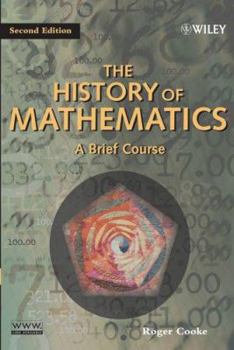The History of Mathematics: A Brief Course
Select Format
Select Condition 
Book Overview
This new edition brings the fascinating and intriguing history of mathematics to life The Second Edition of this internationally acclaimed text has been thoroughly revised, updated, and reorganized to give readers a fresh perspective on the evolution of mathematics. Written by one of the world's leading experts on the history of mathematics, the book details the key historical developments in the field, providing an understanding and appreciation of how mathematics influences today's science, art, music, literature, and society. In the first edition, each chapter was devoted to a single culture. This Second Edition is organized by subject matter: a general survey of mathematics in many cultures, arithmetic, geometry, algebra, analysis, and mathematical inference. This new organization enables students to focus on one complete topic and, at the same time, compare how different cultures approached each topic. Many new photographs and diagrams have been added to this edition to enhance the presentation. The text is divided into seven parts: The World of Mathematics and the Mathematics of the World, including the origin and prehistory of mathematics, cultural surveys, and women mathematicians Numbers, including counting, calculation, ancient number theory, and numbers and number theory in modern mathematics Color Plates, illustrating the impact of mathematics on civilizations from Egypt to Japan to Mexico to modern Europe Space, including measurement, Euclidean geometry, post-Euclidean geometry, and modern geometrics Algebra, including problems leading to algebra, equations and methods, and modern algebra Analysis, including the calculus, real, and complex analysis Mathematical Inference, including probability and statistics, and logic and set theory As readers progress through the text, they learn about the evolution of each topic, how different cultures devised their own solutions, and how these solutions enabled the cultures to develop and progress. In addition, readers will meet some of the greatest mathematicians of the ages, who helped lay the groundwork for today's science and technology. The book's lively approach makes it appropriate for anyone interested in learning how the field of mathematics came to be what it is today. It can also serve as a textbook for undergraduate or graduate-level courses. An Instructor's Manual presenting detailed solutions to all the problems in the book is available upon request from the Wiley editorial department.
Format:Hardcover
Language:English
ISBN:0471444596
ISBN13:9780471444596
Release Date:April 2005
Publisher:Wiley-Interscience
Length:640 Pages
Weight:2.85 lbs.
Dimensions:1.3" x 7.2" x 10.2"
Customer Reviews
3 ratings
Trust
Published by Thriftbooks.com User , 16 years ago
I've spent a long career trying to establish a few solid relationships between mathematics and the sciences of mind. Thus, it is truly a great pleasure to read a book on such a vast and deep subject as the history of mathematics and be thoroughly able to trust the author's knowledge of it through chapter after chapter.
A very proper emphasis on the historical context and chapters on the role of the non-western world
Published by Thriftbooks.com User , 24 years ago
Approximately every three years, I teach a course in the history of mathematics. It is one of my favorite math courses to teach, because it allows me to delve into the historical and cultural context of the development of mathematics. Among other things, I was a history minor in college, and if you learn anything in that field, it is that events are never isolated. Everything takes place in a social, economic, cultural and historical context, and that includes the development of new mathematics. Cooke is obviously as much a student of history as he is of mathematics. The technical structure of the mathematics is explained within the historical and cultural settings. There are many exercises at the end of the chapters with solutions to some of them included at the end. The coverage of the development of mathematics in the western world is fairly standard. Cooke is to be commended in that he includes sections on what was going on in the rest of the world. Section II contains the following chapters: *) Mathematics of the Hindus *) Chinese mathematics *) Korea and Japan *) Islamic mathematics Many mathematics books mention the role of the Islamic nations in keeping the ancient mathematics alive. However, there is little acknowledgement of what was going on in other cultures. If there is a mention of mathematics outside the western sphere, it is in reference to the creation of our modern numeration system. It may be some time before I teach the history of mathematics again. If I do, I will once again place a great deal of emphasis on the history, something that Cooke does so very well.
An excellent book!
Published by Thriftbooks.com User , 26 years ago
This book is a fascinating look at the history of mathematics, and is sure to inspire even the most devout haters of numbers.





